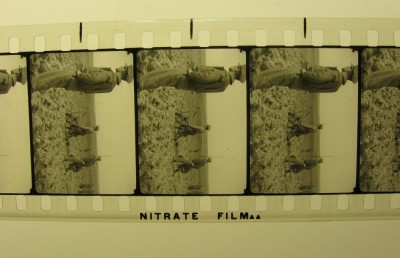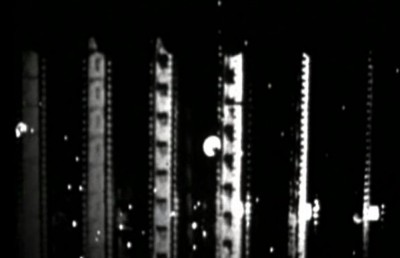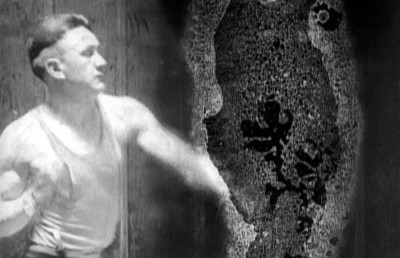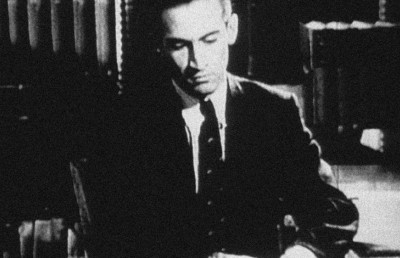Matter and Memory: A Conversation with Bill Morrison
Cinema from the Ruins of the Archives
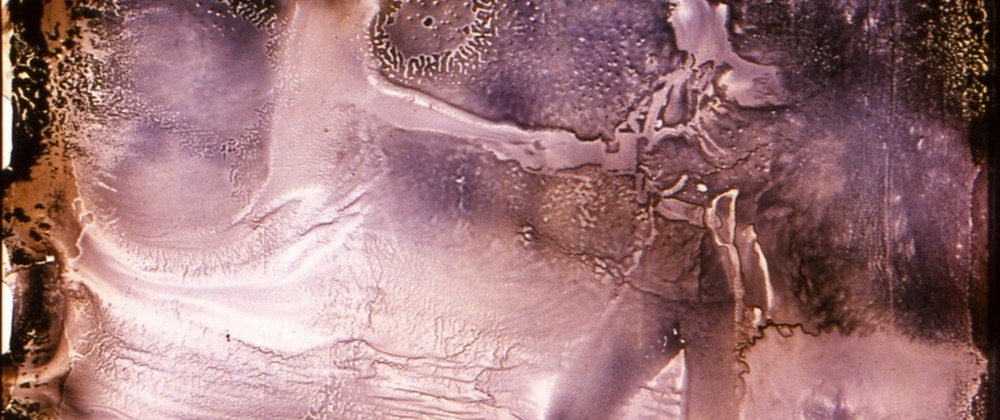
It is during the retrospective of his work that was held in Montreal, on April 28-29 2004, at the Cinémathèque québécoise, that New York filmmaker Bill Morrison gave us this long interview, in which he discusses his background, his career, and certain essential features of his artistic and intellectual process, dwelling on issues concerning new technologies, the memory of the film material and the historicity of the filmic medium.
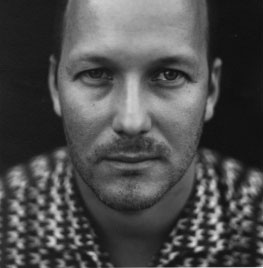
Since this interview, the films of Bill Morrison have been presented at the Cinema ritrovato Festival, in Bologna (July 2004), at the Étrange festival in Paris (September 2004) as part of a vast homage, at the International Film Festival in Vienna (October 2004), and many more. St-Ann’s Warehouse in Brooklyn hosted, from the 9-12 September 2004, the American premiere of the live-show of Decasia, which had been presented only once before that, during its premiere in Basel in Switzerland. The film, Decasia, was projected on three screens, with the audience sitting in the middle. In between the screens, Laurie Olinder’s sumptuous slide projections moved on large white surfaces, while 55 musicians, perched on three-story high scaffolds behind the screen, played Michael Gordon’s hypnotic symphony, under the direction of Patti Monson. This major event, troubling in more ways than one, was able to recapture the truly spectacular dimension of this film-symphony, to replay the origin of the project (that Morrison recalls in the interview), and to remind one of the theatrical origin or performative aspect of most of his films. This confirms once again the exceptional nature of this work and of the symphony that accompanies it —which gains a lot when heard interpreted by a live orchestra— which keeps mesmerising audiences.
If Morrison has, in recent years, imposed himself as one of the most important experimental filmmakers of his generation, it is because he has understood the possibilities of a poetics of the archive, of the historicity not only of cinema but above all of its material base and of its modes of projection, exploring and expanding all its limits. It is a clear, lucid and generous voice that he presented to us during this 2-hour conversation, which only confirms that his work touches on some of the most crucial stakes in cinema today.
Offscreen: There are first of all a series of questions I want to ask about your professional background. You began your artistic career as a painter?
Bill Morrison: Yeah. I grew up in Chicago, and I always drew and painted without any particular idea of making a piece of art, that is, until I got to New York. There, I entered the art school Cooper Union in 1985. Very soon I started taking animation classes with Robert Breer, who was also a former painter. And so I was in a way inspired by him to bring my painting more into animation, and as it turns out, more into film.
Offscreen: Did Robert Breer teach you how to work on the optical printer?
Bill Morrison: Breer’s retired now. I never found that he knew too much about the optical printer. What he knew how to do was the type of films he did. There was somebody else there to instruct us on the optical printer. Breer works in his self-styled manner of drawing on index cards, shuffling those and then photographing each one at a time on an animation stand. He has been working this way for 40 or 50 years. I was more inspired by him because he seemed to have this mid-Western sensibility, and a very dry sense of humour. He didn’t suffer fools or pretension. That was quite refreshing for me being in New York in the height of the 80’s painting boom; there were a lot of students parading around as if they were going to be the next ‘Mary Boom Star,’ and there was a lot of art speak going on that I didn’t relate to. And so Breer re-assured me that I could be myself and still exist in the art world.
Offscreen: How do you relate with the New York experimental scene in the 80’s and 90’s? I know your first films where done in relation to stage productions. How did you juggle those two hats?
Bill Morrison: Well certainly I saw myself as part of this scene, insofar as it existed. I was showing in the same venues if not always in the same programmes with some of the people who were 5 or 6 years older than me. Because those films had a context with theatre and relied heavily on music, it was embraced as pure cinema (although not in the same way some of the more hard-core experimental filmmakers would term it). For me, they were films that existed in theatre, because they were about the moment. And theatre is about the moment, it’s about what’s happening between actors or performers, in front of a live audience. When it’s taken out of a live theatre context, it looses this dimension. But I think it’s still about the screening experience.
Offscreen: This performative dimension seems very well integrated within your films. I’m thinking of The Death Train for instance, or Footprints, where there’s a roller coaster ride feeling, or a variety show spectacle.
Bill Morrison: The images for Footprints were presented in Ridge Theater’s production Jungle Movie. As I recall, when we showed the film, we really just stopped the performance. We had some actors shuffling around in front of the screen, but basically it was in the variety show mode where, boom, we stop production and now we watch a film. The Death Train was much more incorporated into the set, into the concept of the piece as whole. When I am creating films for theatre, I am leaving a lot of space. Although some times I have an edit sound, the images aren’t married to a specific soundtrack. This allows space for my collaborators: Laurie Olinder who does the slide projections, and the director Bob McGraff, who works with the lights and the performers. This isn’t all mapped out ahead of time, but during our tech-week, we come with all our different elements. It’s important that my films not be too bright, for instance, or they will flood the light. Or it’s important that there’s enough space in them so that other things can happen. A lot of times the bulk of the footage was created with this in mind and then later on it was edited to tighten it up. It also creates this thing where the audience member is the protagonist in these films. The audience members are sitting there without a lot to guide them and basically they become, theatrically, projected in our film. The audience becomes the protagonist of these films.
Offscreen: Your films really seem to reproduce, in more ways than one, early spectatorship. Academic studies in this area have tended to stress the fact that there wasn’t a clear separation between theatre, film, magic shows, and that early cinema relied heavily on audience interaction.
Bill Morrison: Like in Vaudeville also.
Offscreen: Of course we can think of Vaudeville, but also rollercoaster rides, fairs, universal Exhibitions. All these things were part of the same historical moment that radically re-defined, within and for modernity, what a spectator was and still is today. I see your films dealing with all these issues.
Bill Morrison: Yeah, including packing rolls of films in my 94’ Saturn and driving up to Montreal. The showmanship continues a 100 years later ! “We’ve got films ! Come see the picture show!” And I use that last term consciously. We were talking last night about that French word that doesn’t exist in English: “déroulement.” I think of these films as indeed coming out of Breer’s animation in their attempt to show you many pictures in a second. But you are also aware that you’re looking at separate pictures. The essential element of these things is a painting. A painting that can’t be stopped, and that’s important too, that as soon as you see it, it becomes part of the past. And that you are watching history and that you are unable to grab it, and hold on to it and look at it. This is really what separates cinema from the other arts. And indeed maybe it’s the most basic analogy to our lives: at no point can we actually freeze a moment and hold on to it and say: “This is it. This is the moment right here.” The moment we have said it, it is gone and its part of history. So our whole experience is a memory of that. Art is able to verbalise that this thing is happening now. It’s an act of history.
Offscreen: I want to ask you a question about the principle of repetition that governs your cinema, and that seems linked to this question of memory and reminiscence, that you were mentioning. Repetition, like the act of re-membering, is not the return of the same, which would simply be redundancy. Repetition, or the return of certain images, shows us that as it comes back, it’s not the same image, since they’re included in a different series, according to the way they are linked through the montage. And even from one film to another, there is a pleasure of seeing images that we saw in earlier films, and seeing them again in ??Decasia??…Those images work like your own memory in a way. In your memory process, images re-appear.
Bill Morrison: Yes, absolutely. In The film of Her, Trinity, The World is Round, you have a number of those images that are reoccurring dealing with the archive: a hand going in the bath, selecting a film, that turn into clouds and going from there for instance. The guys working in that old lab, with the films wrapped around, and that’s re-produced. It’s actually the same piece of film that was used in Decasia. And so these become the ‘Greatest Hits of the Archives,’ and I think of them as film gods, who are working in your brain: they are holding old to memories and they’re plunging them into the bath and they bring them back out. But to see these images come up again, I think: “I’m making the same film over and over again.” At the same time, those images have become part of my own personal archive now. With this trajectory, these images come to represent more and more, and now, it’s as if I don’t have to go from the evolution anymore to get to there. I can take that and say: “this means this house of ideas.”
Offscreen: Let us move back a little in time. What was your first encounter with the archives, or with archive films? I remember in an interview you had mentioned seeing Ken Jacobs’ Tom, Tom the Piper’s Son at the MOMA, which made a strong impression on you.
Bill Morrison: I can’t remember whether I saw the film or if I read a programme note on it first, in which Jacobs credits Kemp Niver, the man who in the 1950’s and 1960’s developed a very crude method of taking these sprockets-less rolls of the Library of Congress paper collection, and re-photographing them one at a time. And I saw this maybe in 1992 or something, when I was doing a lot of optical printing. Foot Prints, Lost Avenues, Night Highway, Photo Op, these were very optical printer intensive films, that use loops and so on. Also, I used a lot of old footage that perhaps would never have see the light of day. I didn’t know much about this character, Kemp Niver, except that he was being credited with taking these films that had otherwise been on a shelf, and bringing them to light again. Doing research on Kemp, I found out about another guy who was even more forgotten, Howard L. Walls, who had actually brought them into light but couldn’t make that final step to get them in front of a projector lamp. So The Film of Her became about him. It was an analogy of myself, the kind of futility of making this kind of film…
Offscreen: It seems to me that, within the history of American found footage films, your films have a particular status. I see you more in the Cornell tradition, in line with his Rose Hobart.
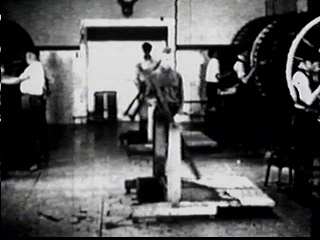
Bill Morrison: But that’s already 60 years ago…
Offscreen: Yeah… But I don’t know of anyone else that really does what you do…
Bill Morrison: Bruce Connor.
Offscreen: Connor, it seems to me, doesn’t have the same dynamic. He’s recycling the images, but it doesn’t seem that his films have the same type of…I wouldn’t call it nostalgia, but maybe melancholia. He doesn’t bring in this issue of history and memory with the material nature of the medium, which seems to be so much in part what you do. But let me reformulate it in a more proper way: How do you relate to the found footage tradition in American Avant Garde?
Bill Morrison: You know, when artists, in general, go about making a piece of art, they don’t think about how they fit into a tradition. As it turned out, there was a tradition here that I of course was aware of through school and through the New York Experimental scene. Did I at one point say to myself: “I want to be a part of the found footage tradition.” No. I was making paintings that were representational, figurative, concerned with light and landscape and this sort of thing. And realising that this had its limitations, that I wasn’t able to control more than a moment, that I was capturing an emotion that was too ephemeral to be object-oriented, in one frame. Film isn’t that: it’s many pictures, and you can control the music and how long you listen/look at it for. The emotions I wanted to convey in my art, became more easy to convey with film, so that’s how I gravitated out of painting. I didn’t trust film per se, like the artistic films they were making down the block at NYU. Nor did I particularly fathom this idea of putting a piece of film in a camera and letting it go. I’m still trying to work myself up to that. I had to somehow still interact, or inter-phase with it. I started out making this cross between animation and motion-picture photography, where I would shoot negative and then I would take them into the dark room and make individual photographs from each negative. I would then paint on each frame, and re-animate the film. It was the kind of thing you could only do when you are 19 or something like that. It was incredibly labour intensive and toxic. You work for weeks and weeks and weeks to get a couple hundred of these things. At any rate, what I found with in found footage, specifically in older archival footage, is that it had this quality of having been touched. Having been touched by time, by a non-human intervention that is organic if you want to be romantic about it, that there’s some ‘Higher Power’ that had interacted with the stock. When you work with the paper print collections, you become aware that you are watching many paintings that have been re-photographed 60 years after they were taken, and continue to be re-photographed today. So there are many things happening between the first time they were registered on the 35 mm negative and transfered to a paper intermediary, to being stored, rained on, or being nibbled by rats; the hairs in the specs, the grain and what would have to happen for that to be brought out and to be re-photographed some 60 years later. So each picture has its own dimension of time, its own history. Whether or not you are conscious of this while watching, you are still watching these tiny histories go by and that was very powerful to me. This, in a way, satisfied my pictorial urge as well as still, somehow, giving a picture show. Another point which we touched on last night, was this question of finances. I was lucky, very early after art school, to be brought into the fold, into this theatre company that needed weird films. If you peruse the bulletin boards in art school in hope to find an ad saying “experimental filmmaker needed to make bizarre non-narrative,” they just weren’t there. I was very lucky to find Ridge Theater. It’s not as if they were offering a lot of money, but they were offering a community and they appreciated what I did. Which was great. And there was this way in which these films did not entirely disappear in a vacuum, which is often the case with these short film programmes. You bring your mom, your dad and your sister, and the programme is very often like a caricature of a lot of the stuff that gets thrown into an avant-garde film, be it subversive or simply bad…Even today, I am still making short films. I just made this film, Light Is Calling, which was at the Pacific Films Archives earlier this year. I told my sister who lives in Berkeley that my film was going to be shown and she of course felt obligated to go and we talked afterwards, “It was so great, it was the first one in the programme”. She got to go in, watch it and get out of there. Which doesn’t mean you have to trash everything else, there are hidden gems everywhere, but it’s often not the context in which you want your work to be seen in because, of course, it is so uneven.
Offscreen: Did you bring the found footage to Ridge Theatre, or did the company have the idea of working with archival images in the first place?
Bill Morrison: They didn’t have any parameters of any sorts so that was why it was an ideal situation for me. What they had was a small budget. I understood that I could go out and shot stuff, on my own – which I did for the first production. I realised that I could also get a hold of the paper/print stuff that, at the time, cost 60 cents per foot… It was the most economical situation.
Offscreen: The Library of Congress sent you the prints?
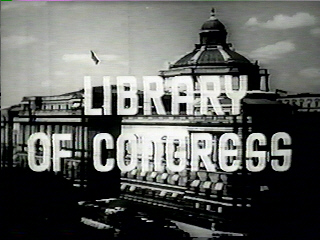
Bill Morrison: Yeah, you could order what you wanted, and they would send you these rolls of 16mm films. You can either do it ‘sight unseen,’ which is a real crap shoot, or you can go down to Washington and pull them up. Back in 1992 when I was dealing with this collection a lot, they were a little quicker about it. The last time I had to order something from the Library of Congress, I realised I needed someone from higher up to call down and say “You have to move that one along” because at this point they won’t even tell you how long it will take. But back then you could basically fill out a form, fax it and go down to Washington and find stuff. What interested me in this collection was the fact that you could basically say : “This is the beginning”, which we don’t really have in other forms of art history. It wasn’t that long ago, whether you want to say it is Fred Ott’s Sneeze ??(1891) or whatever, there is something you can say is, if not the beginning, then very close to the beginning. And obviously cinema has had a huge hand in shaping the way we are and the way we think and the way we dream in the last hundred years. And so we can say it all started here. So I was looking for images of the evolution of man: monkeys, whatever they were, iconic lost images that were about how we could be brought from one species of pre-cinema into this new modern species that we are now. I would have lists that were made up of: cavemen, monkeys, early babies, things that indicate early times, the morning or spring. And from ??Decasia, I feel like I started out again, after you get through the laboratories and these references, you get into a story, finally, after several introductions: you are in the clouds and your clouds are separating and finally land. It is again a creation of the world.
Offscreen: So basically your encounter with these images was a way of putting them back in motion, to bring back to life this material, to show the origin.
Bill Morrison: I guess so. But I was also doing these films within and for these stage productions. I didn’t know how appropriate it would have been to propose a “personal cinema,” like these keenly observed moments of my life, and that all I had to do was to go out with the camera and shot things around me. I didn’t know how that would translate in a theatrical world. I did want to make big broad sweeping statements about memory, time, loss and history, and this I could achieve through archival footage without saying “I’m a sensitive guy with a camera.” This wasn’t the format for that. Besides the economic question, those were issues that interested me. Chris Marker’s La jetée was a hugely compelling film for me. I saw, with that film, that you could talk about these things without having to explicitly talk about them.
Offscreen: There’s another film, directed by Alain Resnais, but that Marker wrote the commentary for, Toute la mémoire du monde, (1956) which is very close to the issues you bring up in The Film of Her. Marker is another film maker who, although he works in very different ways from you, is very interested in this relationship between archive and memory. All of his films deal with the question of imprints, “impressions”.
Bill Morrison: Absolutely, that film was a huge influence on me. I saw it in 1992. I’m glad you saw it, because it’s true, The Film of Her came directly out of that. I remember the hair raising up on the back of my neck when I saw this film… People often ask me if I would show my work and also curate films by other filmmakers to show and it’s always a perplexing questions, to bring in other experimental filmmakers and see how they relate other than the fact that we are working on our own. But I’ve always wanted to show them Toute la mémoire du monde. But it is impossible to get a hold of it.
Offscreen: The collaborative work has had a considerable importance in your career and has shaped many of your films. On the other hand, when we read about people that work in archives, the thing that comes up all the time is their solitary nature. How do you achieve a balance between those two tendencies?
Bill Morrison: In a certain way, my role has been as a bridge, taking this stuff from long ago and seeing how it would work in a contemporary context, taking this music and putting it to these things. It’s a solitary mission control, centred in the ideal world I am setting up. In the great context about the theatre company, often times it is a blank slate. With Decasia, we had this opportunity, but what was it going to be about? It was completely left up to us. As it turned out, I came across a lot of this decaying footage at the same time, and so I proposed to do it about decaying and footage. I didn’t think anyone would be shocked to hear me say that, since I had been giving them decaying footage for a long time. It was the first time that we made it a part of the central focus of a theatrical piece.
Offscreen: Was the footage for Decasia edited after the symphony was written?
Bill Morrison: The symphony wasn’t written yet, but we got the information and the dates for the show in Switzerland, which was to be held during “European Music Month.” They had commissioned Michael Gordon to make a new symphony, and for Ridge to make a visual element that would somehow make it a theatrical evening. And maybe because there was going to be a visual component, they were referring to this event as “Fantasia.” I felt we should change the name as quickly as possible. So when we decided to make it about decaying footage we came upon the name Decasia. But here again I moved quite laterally away from your question. How do I reconcile…
Offscreen: The fact of working alone…
Bill Morrison: And the collaborative… I guess a lot of filmmakers work in a very collaborative manner to the extent that they loose control of certain aspects more or less. They have to have people that they really trust, who are making edits or deciding what’s in the frame. I feel that I have a lot of control of what we actually see on the screen, especially in the archival stuff. The collaborative aspect of the work appears mainly with the music and the theatrical component. My relationship with Ridge now is excellent. They basically trust me that this thing is going to work with the other elements. And with Bob, and Laurie and myself, we have a lot of faith where those boundaries are. So I just think of the collaboration in a different way, in some ways more passive. The composers find it very fulfilling because I end up editing to their scores. Often, I go have interviews with Michael Gordon and they ask us to talk about our collaboration together. We do more collaborating in that question and answer session than we do in the years that we’ve known each other. He works alone. He writes his thing on a computer in a room and then myself and other members of Ridge take that score and are able to interpret it and figure out what would go where. So that’s also a collaboration on two different platforms. It’s nonetheless a passive collaboration.
Offscreen: During the 1980’s, in New York and elsewhere, a lot of people were switching to video, or exploring the possibilities of video. At the same time, it seems that the emergence of video and digital triggered a lot of artists to move “back” to film as film, as a way of maybe reacting against the immateriality of the other mediums. How do you feel about video? I know you did a couple of films on video (East River, for instance).
Bill Morrison: I think that with video as you rightly point out, you don’t have a physical thing that you are allowed to access, and if you do, then you don’t have a video. If you’ve touched this tape, for instance, it’s pretty much over. Or it’s gonna be soon. Whereas the films that we were discussing earlier are very much about a compilation of pictures that rest on your ability to touch them. And even though it is difficult to get at them, you can get at them and they are essentially intact. I approach the medium differently that way because of economic necessities. The last piece we did with Ridge Theatre was a show called Gotham, that played at Carnagie Hall in February 2004. We realized that it’s no longer as easy to bring in slide projectors and 16mm projectors and do our multi-media show that way. People say: “Oh we haven’t seen that stuff in a long time. What we have now is this projector here. Are you coming from a computer or a DVD?” That’s your choice now. It’s not even about a tape anymore. Having to adapt to that platform has forced us to make those changes too, and there are good things that have come out of it. It does strike me sometimes as a little ironic to be watching these old films that are now being transferred onto video tape and fed into my computer. Or then to a file that then got transferred weightlessly into somebody else’s computer and then got brought up to the show to be projected. It seems to have gone a long way from the moment when they were registered on this piece of emulsion however many years ago. Still I think when I shoot video, and I shot live video, I am interested in things that I can’t do with film as easily, obviously audio, but also as you call it “the dilation of time.” With video you have this capacity to make very long shots that can have a single event or not. With film you can record distance very well. With video it’s pretty much best in this situation with a person pretty close to a microphone, without a lot going on in the background. There are formal elements to consider. I haven’t been completely disappointed with the way some of the more fluid, organic, distressed look of the DVD of Decasia. It’s obviously something that you can’t create from video, it comes from somewhere. There’s something about the digital frames, and how they relate to each other that makes it somehow even more violent than it is. I don’t know exactly how to express what it is but it has a ‘pop’ that is different than when you watch it projected, which somehow has the violence to it which I like. Obviously the digital revolution is to be applauded. It’s opened up filmmaking to a lot of people, and a lot more can now be captured. That being said, I think that what is remarkable about early newsreel footage is that there was this fascination with how things moved. Today you don’t find someone taking a 35mm camera, much less even a video camera out to the desert to watch a procession of camels walk by for 11 minutes. They had the freedom to do this, but there was also a fascination, a real need to do it. There was a producer at the newsreel office saying: “Here you get this many thousand of feet, fill it all up and take it back.” And they’ll use maybe a second or two with some cheesy voice over and have a newsreel. And the rest of it is just this documented scene. And these guys who ran the camera must have been really thrilled by that. Thrilled to have this opportunity to re-see the world through a recording device. And I think video in some ways has allowed us to do that too, to say: “I can point a camera at this and I have the freedom to do that.” The problem is that anyone can do it. It’s absolutely not special anymore. Now I am starting to go to experimental film shows where kids are young enough where their entire lives have been video-taped. Whereas, “in our day,” your parents had to be into super 8 film – my parents did 16mm film – in order to have a pile of video baby-footage.
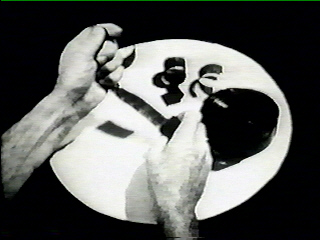
Offscreen But they never watch them.
Bill Morrison: No. Nobody watches them.
Offscreen: Whereas Super 8, and probably even more in 16mm, there was a whole ritual you had to do in order to see them. Every 3 or 4 weeks or 3 or 4 months, you had to setup this installation. But there was a desire to see these images, a pleasure to see the family vacation, etc.
Bill Morrison: Yeah I think that there was that event, that goes back to the showman who may be your father, or who ever the projector-meister was, who took out the screen and turned down the lights and it was this after dinner thing. And now we lose that if we say: “now we’re gonna watch something special on TV.”
Offscreen: And the tapes are there, waiting.
Bill Morrison: Absolutely.
Offscreen: But I guess that’s part of the greater history of the medium. The more it’s available, the less urge we have to see them.
Bill Morrison: Do we still have our beta-decks from 1984? I don’t know…
Offscreen: But that’s also the great difference between film and video. It’s very hard to find a Pathé 9.5mm projector today, probably even more difficult than a Betacam player. But if you find some 9.5mm footage, it is possible to reproduce these images, at least the frames, to retrieve the images.
Bill Morrison: I don’t know. You’d probably need a 9.5 gate…
Offscreen: What I mean is there’s still a way of seeing the images…
Bill Morrison: You are right, if you have home movies on 9.5mm film. I’d love to see them! Yeah you can probably take them to your national cinematheque and have them transferred…
Offscreen: It’s possible that they may have the equipment to do the transfers, but the fact that it’s film makes it more simple. I’ll give you an example. After the fall of the Berlin Wall, all the police archives were discovered. They were on these gigantic magnetic rolls, that worked on these bizarre Soviet computers, that probably could only run in the Soviet Union. By the time they retrieved the tapes and began trying to read them, nobody knew how to run the computers, the machines were all broken or non-existent and it took them forever to figure out how to work the thing out. They had to rebuild the machine to be able to process this data and it took them years (I’m not even sure if they managed to do it). With film, you just have a format problem. It’s some kind of analogical element that you can re-compose, which you can feed in front of a projector to run it and get an idea…
Bill Morrison: It’s an optic trace after all…
Offscreen: That’s something that has always fascinated me which makes this whole blind fascination with the digital machine, in my view, a little dangerous. Even in cinematheques now they are considering switching some of their operations to digital, for money issues: “Why should we bother getting this expensive print, since the DVD projectors are getting better, and soon people won’t even see the difference. For me there is a drop there, there is an ontological leap if you decide to make a DVD pass for a film.
Bill Morrison: But there are also huge issues about actually storing these objects. They have to be in vaults at a certain temperature, if you bring them out they have to be put through a decompressor chamber, etc. We are accumulating all this stuff, again, that not many people are going to watch. And of course we are terrified of loosing it, and it’s always considered a tragedy when we lose something. But what are we actually doing? We are just building up this residue of our existence and somehow cherishing it as a record, and it’s insane. And now the Library of Congress is building a huge state of the art building in Virginia that will house more and more of this stuff, and it will all be 40 degrees Fahrenheit. And the outer chamber will be 54 degrees….I often wonder if this footage was ever shot for this purpose? I was saying to Laurie last night, that it is strange for me to watch these films because I didn’t make them with the idea that, 14 years later, they would be screened in a Cinematheque. They were made for this theatre piece originally. So it does beg the question: what was the original intention of the people who made the thing? And certainly in Decasia, with those people waving at you, at best, they are waving at the camera-man, whose saying it’s time to wave, I guess? Or in an extremely rare circumstance they could end up making the edit of a newsreel where there would be a real thrill to see themselves for a few seconds. Certainly there was a whole industry of camera-men who’d come to town, shoot all the local people and the next week would show up with that film and the real gimmick was if you paid a nickel to get in, you might see yourself on film. It was a very profitable way to make these type of portraits. I degress…
Offscreen: I’m glad you brought up this question of destination, and purpose. Most compilation films that contain early film footage try and document each film as much as they can. Who shot it, for what company, in what year. Everything is described, identified…On the contrary, your films seem to work by defamiliarisation. You move away from the original destination to make it into something else, ‘de-functionalizing’ it and thus making it appear as an image. In a sense, if you know what they were about, you stop seeing them…
Bill Morrison: No, you see them as historical artefacts…
Offscreen: It’s like any image you see in a documentary for instance, with the voice-over saying: “ in 1982 bla bla bla”. You see Gorbachev passing or something, but you know, you don’t really see Gorbachev, you have someone telling you that Gorbachev is there. One hundred and fifty years from now, if you have this image–without any commentary or context– of this guy going down thse steps, you slow it down, you see a strange thing on his head, you have no idea who he is, you see something, you are actually doing something, looking …. For me it’s the great force in your films, it’s not knowing where they are from, what they are meant to do, but you are actually looking at something…
Bill Morrison: I’ve shown Decasia in archival symposiums, and archivists rushed up to me afterwards and were saying: “But you must document what all these are”. But I agree that somehow that would defeat the purpose. And it would make it seem a plea for preservation which I’m not actually doing. Certainly none of this work would exist without preservation. I am greatly indebted to them but I’m not saying it is necessarily tragic that time erodes these things because, hey, that’s what happens. It might be too tragic if we allocate too much money towards saving stuff that we don’t need to save. There’s some stuff that absolutely should be saved. And there’s other stuff that shouldn’t just be saved because it’s old. We should do our best to give it a house where it can live. But I don’t think we restore everything to its perfect pristine level…
Offscreen: Restoration or preservation are two different cases. The question with preservation–which for me is more important and urgent than restoration–is : what do you keep, what is your criteria. Often you have piles of films simply labelled “industrial.” Nobody really knows what’s in these boxes. It can be a classical masterpiece, misplaced, or it can be 40 copies of the same film of a guy walking up a ladder. You have no idea what’s in these things. And often when they clear out archives, most people are not very caring. There are horrific stories that have developed into this paranoia, where everyone is terrified of destroying something precious. With that, the funds of restoring and preserving films, in Canada at least, are very thin.
Bill Morrison: It’s true, it’s like that everywhere. Nobody has money to restore old films. No I don’t mean to say: “Throw them all out, we don’t need them…” Quite the contrary, my whole career has been built on the work. But what I mean to say is…
Offscreen: It’s the fetishism, or the idea of wanting to save everything…
Bill Morrison: Yeah, or maybe it’s just that we need to find a new model for it. Maybe it’s the “the objectness of preserving film.” It’s as if it’s the only way we can think of doing this, because of course the different mediums of recording and transmitting this stuff is always in flux. And the only thing that everyone can agree upon is that with 35mm, we’ll always have a way to look at this, no matter how many hundreds of years go by, this is the archival “Rosetta stone.” But the magic of cinema is also it’s fleeting nature, not only it’s objectual nature. Is there a way of eventually recording all of this stuff so that it can exist in this world? It is obviously going into a more digital unit. It’s not just a fad, we are obviously beginning to operate much of our lives in some sort of another of digital communication. So can archives somehow be digitised? One idea that I heard a guy suggesting was not unlike how you take your bank card and put it into a slot, and messages sent after some time, the money comes out. Digitising could exist as continually floating from one terminal to another and then, if you know what the next terminal is, you can ask that terminal to send it to you. And somehow it’s all bouncing around and somehow the idea that it is not taking up physical space is attractive to me. On the other hand, I realise that as soon as this system is put into place, all our visual history will rest in the difference between a one and a zero. So it would be foolish to count on that as the full-proof plan perhaps.
Offscreen: You know, when you find a stone, let’s say, from the Neolithic age, even if you can’t decipher it, there’s a way to know if someone carved something on that stone. Even if you can’t use this, archeologically speaking, there’s a great affective power that is stocked in this piece of surviving stone. Whereas, if your terminal has a bug, what’s left? What is left, how can you recover it once it’s lost?
Bill Morrison: I’ll be presenting a seminar on a DVD-R tomorrow and we won’t know until we get there what is actually going to happen. But I did bring some old VHS as back up, which I find you can really rely on…
Offscreen: It’s funny when you think about it, how we have now admitted a greater part of machinic irrationality when it comes to the tools we use every day since the advent of digital technology. How many times do we say : “I don’t know what’s wrong with my computer these days.” These machines have moods, almost feelings, that are hard to explain, and we feel that we don’t need to explain them. It’s just like that.
METHODS AND MANIPULATIONS
Offscreen: Now let’s get back to the questions. We went through many roads thus far, but I would like to ask you a few questions now concerning your work methods. I’m thinking in particular of Decasia, and your two more recent films, Light is Calling and The Mesmerist. Do you always start out with an original 35mm print?
Bill Morrison: In the case of Decasia, there were time where we’d go back to the original films, and they didn’t exist anymore but since they had already become part of the scenario we had to find a way to include them in the film. The master than became the video reference copy (that we had made a few years prior), rather than going back to the 35mm negative… So in those cases, we were transferring from video to film. It was the case for a dozen shoots, a dozen scenes in the film. It’s pretty tough to see because they are black and white, but a trained eye for looking at can certainly tell. In those cases, I would heighten the contrast, to show the decay more. But I wouldn’t go as far as to introduce any kind of effect on it. The thing that fascinated me was the degree to which these things had decayed organically. But it is a question that I get every screening: “how did you do it?” And even if I come in with an introductory comment and say that this is all done organically, there is always someone who came in late and says: “how did you do it?” I’ve read reviews that say: “It’s amazing what you can do with Photo-shop now…”. Or people ask me “are you developing a plug-in for this sort of effect?” Everytime, it’s really like that everytime. With Light Is Calling and The Mesmerist, we were working directly from the original nitrate print itself. We were making a new negative from the print. There wasn’t even a master, like with Decasia, where I would make a master 35 copy, and work from that. With Light Is Calling and The Mesmerist, we just skipped that step, so we are actually a generation closer to the source…
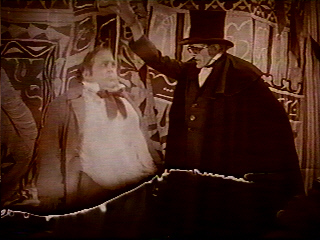
Offscreen: For Decasia, were you working with negatives or positives?
Bill Morrison: It would depend. At times we had access to the original negative, sometimes to an original print, sometimes to an archival safety master which then a negative had to be made from and so on. But the way we tried to do it was we’d get a fine-way master positive on 35 at the regular speed, at the speed it came in, with as fewest frames as possible, and then from that create an optical negative that was stretch printed, in other words, it was slowed down. And we did that. I would have the archival master source material for Decasia, in addition to the negative which we generated. With Light Is Calling and The Mesmerist we simply went back to the source print and the negative for the film from that. The effect you’ll see in Light Is Calling, and in two scenes in The Mesmerist, that’s different from Decasia, is that, as opposed to just being simply stretch-printing, where you might take one frame and print it three times, in order to slow it down, in Light Is Calling, that one frame was printed four times. When you get into seeing the same image four times, it becomes more of a slide show, and you are losing the magic of cinema. One way around that, I found, was to basically take each scene and print it four times longer than its original, and then superimpose on that same scene also printed the same way, four times longer, but knocked out of sync by two frames, so that every frame is seen, basically, superimposed with an adjacent frame. You then have this double, cross-dissolve going on, where you are looking at frame A and frame B and then frame B by itself, and frame C and frame D and then frame C by itself. You see it when the guy is collecting money in The Mesmerist for a second, in the eerie scene where he is looking back at the Boris Karloff character. It gets a little bit trippy. And then the last scene of the guys with the parade of huge heads coming towards you. But all of Light Is Calling is done that way. I tried to do it as a video mock-up first, and had all this interference because you are asking all these bands to co-exist with each other. As it was strobing it was very difficult to look at so I decided to do the whole thing as an optical, which was much more successful.
Offscreen: So you were working with the original nitrate?
Bill Morrison: Well I had a house do it. It’s not legal for me to have nitrate film in my apartment. So I had them make a video tape with time-code. And then I edited that video tape to the specifications and then sent that edit decision list to the house. They still had the original so they would manufacture the new negative from that.
Offscreen: Did you have to pay for the films?
Bill Morrison: No, the Library of Congress simply loans me the prints. The last time I talked with them, they were very interested in getting them back. But they are in this laboratory, and it is like asking: “And when you get around to it, how about sending back those precious nitrate prints to the Library of Congress,” and the laboratory is like: “Oh yeah, we’ll be right on that…” It’s out of my hands at this point.
Offscreen: The film was part of the Library of Congress collection?
Bill Morrison: Yes. The Library of Congress had the pristine negative of the film, The Bells, and they had a pristine reference print. So this really was one of those cases where: “why are we keeping this deteriorated print? This is taking up space, we have to get rid of it…” I had been working there on Decasia. When I came back there they said: “Hey we are going to throw this one out, do you wanna take a look at it?” Unlike almost any other deteriorated print I had ever seen, it had this beautiful deterioration, the image had been altered, however it wasn’t sticky. The first thing that happens is that these things start to stick together. It was perhaps because it had been in good storage conditions, it had somehow deteriorated, dried and it hadn’t shrunk even, so I was actually able to find a lab that would deal with it and make a contact print. The fact that this stuff could run through contemporary machines is sort of miraculous. And I’ve looked at a lot of film and the people there had never seen it either. There was zero shrinkage, it’s in fine condition, yet the image is dramatically altered.
Offscreen: So this wasn’t the case for Decasia, you weren’t able to run it through a projector.
Bill Morrison: Absolutely, the prints were in awful condition. When I talked about trying to go back to the negative, and it didn’t exist anymore, that’s what I was talking about. Here we had a video tape that was made not eight years earlier, you know, referencing this film, and when we got back to it, the print had literally disappeared. A print goes through various stages of “decomp,” as it’s called for short in the archival world. And they also have terms for those various stages, the first one being that the print gets “tacky,” then stickier and then they call it “donut,” because a ring has formed. And then something that maybe came from a Canadian archivist, it’s called a “hockey puck”. And then at that point there is nothing to do with it…you can’t even play hockey with it….then it eventually turns into dust.
Offscreen: Were you directly manipulating the film?
Bill Morrison: Other than stretch printing it, I would touch it sometimes in certain cases where it was actually being rescued from trash heaps. This was an isolated incident. The George Eastman House actually gave me stuff that they were going to physically throw away. So I had a couple of days there with the mask, and the gloves and the goggles, and the vacuum cleaner sucking up the fumes, and the booties over my shoes, real science lab stuff …
Offscreen: It’s like Chernobyl…
Bill Morrison: Yeah, it was just an awful time to spend in there. We worked with a lot of scraps for the multi-media presentation of Decasia. I gave Laurie a bunch of old nitrate footage for her to make slides out of. She didn’t have the benefit of the goggles, or the hat, or the gloves, or the vacuum cleaner. It was a pretty gruesome experience, I think, for her. The original nitrate has been quarantined for a reason. It’s pretty lethal stuff…
Offscreen: And it can explode too…
Bill Morrison: I believe every artist has this fantasy to see nitrate on fire, it’s some sort of sexual metaphor. Anyway, in those cases, I would actually handle the film at that stage, but then it would get sent off to a lab to be reproduced onto a more stable material.
Offscreen: Can you pretty much identify all the films you used in ??Decasia??…
Bill Morrison: Absolutely.
Offscreen: Are they pretty much well listed, in terms of titles, directors, dates, and so on?
Bill Morrison: Oh! I could go back and find that stuff. It might be difficult to find the cameraman on the newsreel stuff, but I could tell you the title and the archive of every scene and then from there it would be a question of paper work.
Offscreen: I guess you had some educational films, some industrial films, colonial films…
Bill Morrison: Yeah I could probably tell you the production company for all those… In order to order these films it was necessary to be able to identify which one you wanted sent to the lab.
Offscreen: There must have been a lot of anonymous images, non identified rolls…
Bill Morrison: That was the case at the George Eastman House, where nobody knew who made it. There are lost films out there that I was open to using. For the most part it was how well they were kept track of over the years, but there is certainly a paper trail for each scene.
Offscreen: In Decasia almost everything we see is hard to date, to identify. You often can’t even say: this is pre-1914. We don’t know. That camel shot scene could have been shot in 1895 or 1930. Did you want to keep that indecision?
Bill Morrison: It certainly wasn’t about film history per se. It was about film history as a concept of history, of consciousness. It wasn’t about, “Ok, then we got into this type of shot,” or “this here is post-Griffith.” Obviously it’s all old and obviously it’s all forgotten, for the most part like you said, maybe you can identify a few things, or movie stars, a couple famous movie stars were in it. Other than that, it’s part of this morass of experiences, of lived experiences, recorded emotions, and I guess the important discrepancy is between which were actuality films and which were narratives. And I think that’s pretty clear. And then they whole Eastern vs. Western thing, or the conflict between the ancient and the modern. Some of these films are meant to represent modernity or a more Western approach to decay. Some of them perhaps represent a more holistic or circular acceptation of decay, of time. But exactly what year they came from is dispensed with, it’s not part of the equation, they are just old. In the past. I read on a web site that someone had listed all the films they had seen, and in that list, Decasia was in the list of older film they had seen. So now I was thinking: “Ok, now it’s already an older film and it’s gotten wrapped up on the shelf, it’s reached that category.” So it embraces that status.
Offscreen: In that interview you gave to the French newspaper Libération, you were saying just that: “my films are also going to rot.” It was interesting to reflect on the life of the films that are made today. At the beginning of one of the films, last night, you could start seeing scratches, which is now part of the life of the print…
Bill Morrison: Really?
Offscreen: It was only slight.
Bill Morrison: Maybe Lost Aavenues or The World is Round. I’ll have to check that…
Offscreen: A last question maybe. You mentioned the name of Godfrey Reggio a few times, and he appears in the credits of Decasia. film. Is he a friend?
Bill Morrison: He’s a friend. Certainly, his idea of making a compilation film to a symphonic score has been an influence on me…You said you wanted to talk about Fabrica, I guess we haven’t talked about it. In 1994-95 Reggio was invited by the director of Fabrica, and he invited me to come out, to be what they would call a student, a person who would work in the studio for a year. That was the connection. But by the time I had arrived he had already had a falling out with the administration, including the founder Oliviero Toscani. So I was in Italy with not a lot to do. So I sent for all my film elements that I had been planning to use for The Film of Her and was able to make it there. It wasn’t much of a collaboration either, they left me alone for a year and I got to learn more about Italian food and wine, which was great. When Godfrey, some years later, found the money to make the third part of his ‘Qatsi trilogy, Naqoyqatsi, he asked me to be an editor on that. I worked on that for 6 or 7 months. During that time I was making assemblages for Decasia, so I was able to use, with his permission, the machines, the AVID, to bulk out sections and stuff like that to give to Michael Gordon while he was writing the music, and even though I didn’t end up doing the edit on that, that time was very useful to me. So you’ll see, I’m credited on Naqoyqatsi.
The interview was conducted by André Habib, on the 29th of April 2004, at the Cinemathèque québécoise. Retranscription: Nancy Baric.


